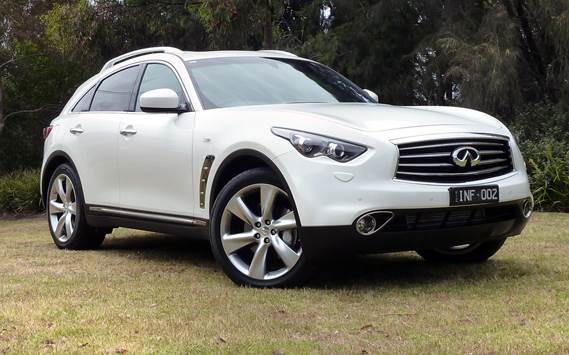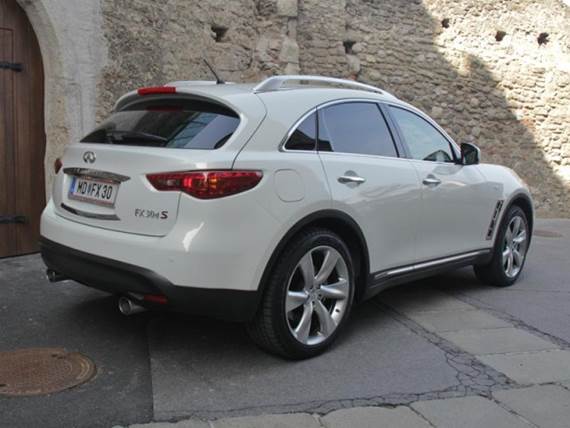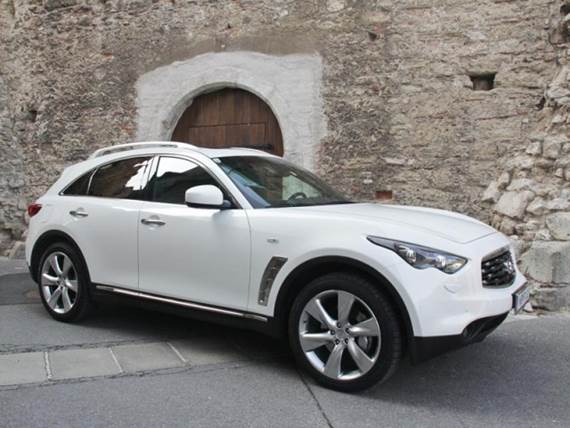The design of Infiniti’s local flagship turns heads. But is that enough to draw potential buyers into the carmaker’s showrooms? We had a year to find out
Bold and confident are words that describe not only the Infiniti brand’s ambitions of following its traditional rival, Lexus, with expansion into markets outside their respective US strongholds, but also the company’s current flagship model.
Until the recently shown Q50 officially launches to celebrate Infiniti’s second full year of operation in South Africa (see our driving impression on page 58), it’s the FX range (recently rebadged QX70 as part of an extensive model-name shuffle) of luxury SUVs that remains the brand’s most appealing model range in our traditionally brand-conscious market. And talked about our FX30d Premium S long-term car certainly was.

Finished in pearlescent Moonlight White, with its elongated nose and exaggerated haunches – complete with standard 21-inch alloy wheels there was little chance of the FX ever going unnoticed round Cape Town. And, for the most part, reactions and comments were positive. That’s ignoring the fact that a number of onlookers questioned which make of car it was; brand recognition is an area Infiniti South Africa will have to focus on heavily. While the family link between Nissan’s Murano and Juke, and the Infiniti FX is apparent when these vehicles are parked alongside each another, in isolation and especially after the recent influx of Chinese brands with similar-looking badges – the confusion regarding Infiniti’s placement in our market was evident throughout our year spent with the FX.
In line with a 2012 facelift of this second-generation FX, the first units that were introduced to the local market benefited from revised interior treatments that included a new instrument cluster and standard heated seats throughout the range. On top-of-the-range S Premium, little is left to be desired in terms of standard luxury, convenience and comfort. Full leather upholstery, offset by wood inlays encasing the transmission housing and chrome-look instrumentation surrounds, provided plush accommodation for all occupants throughout the year, while a comprehensive multimedia system offers touchscreen access to navigation, audio and Bluetooth functionality.

Another standard feature linked to the large multimedia screen is the comprehensive Around View Monitor park assist camera system, a technology that proved invaluable when maneuvering the large FX around town. While obviously designed with the “everything’s bigger” US market in mind, there are drawbacks to the FX’s distinctive profile when it comes to South African conditions. The most obvious of these is placing the vehicle’s swooping nose and large front wheels within parking bays and narrow driveways. Even after a full year of practice, there were still nervous breaths on final approach to most docking stations.

In its quest to establish itself in markets outside the US, Infiniti has sought to introduce diesel engines to its product line-up. As a result, the FX30d was the first Infiniti to feature Nissan’s proven V9X common-rail turbo diesel engine. This 3,0-litre V6 unit proved a solid performer in various driving conditions, offering a healthy dose of torque (550 N.m) for both overtaking and traffic-merging operations. Although adding a sporty charm to the cabin, the fitment of 350Z-in-spired steering-wheel-mounted paddles proved somewhat superfluous; under most driving conditions, the seven-speed automatic transmission proved adequately alert when left to its own devices.

Like those paddles, the adaptive-damping function, which allows for a firmer ride for more enthusiastic driving, remained largely unused. In truth, the already low and wide stance of the FX, combined with low-profile tires, provided all the cornering stability required from a vehicle of this size.
Away from tight parking bays and urban congestion, the FX shone on the open road. Separate trips to Plettenberg Bay and Victoria Bay along the Garden Route, as well as a lengthy drive to Augrabies Falls National Park, allowed the FX to stretch its legs and show impeccable cruising ability. We were somewhat disappointed to discover that the adaptive cruise control was confused by rainfall; in the dry, however, it worked very efficiently.
The part-time all-wheel-drive system added peace of mind on one or two gravel-bound excursions, although the thought of potentially damaging a shiny 21-inch wheel kept us, for the most part, on firmer surfaces.
While we averaged 10,47 L/ 100 km over the duration of our 20 000 km test, on the open road we averaged an impressive 9,1 L/100 km.
Midway through the test, while on a photo assignment on the outskirts of Cape Town, our Infiniti was the victim of petty vandalism. For no apparent reason, and in daylight, the vehicle had two of its windows smashed and a brick was used to damage both the bonnet and right-rear door. As this unfortunate incident occurred ahead of the launch of a Cape Town-based Infiniti dealership, the car was sent to Johannesburg for repair.